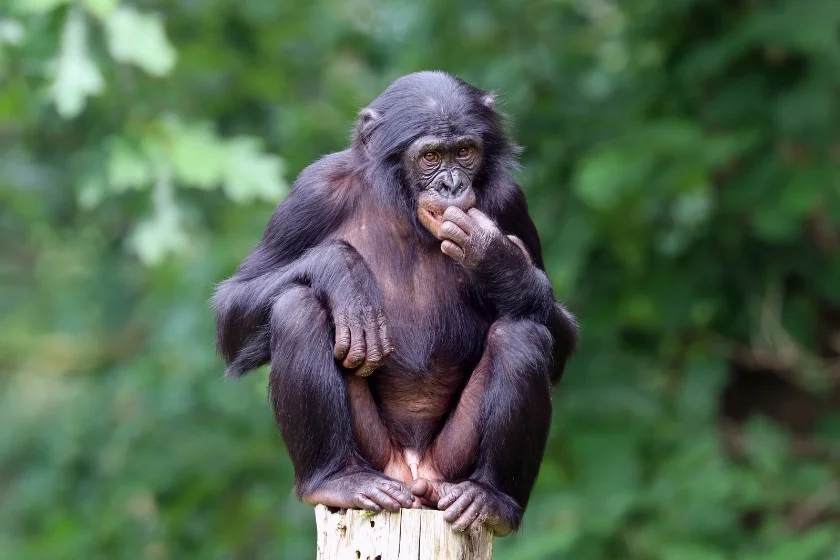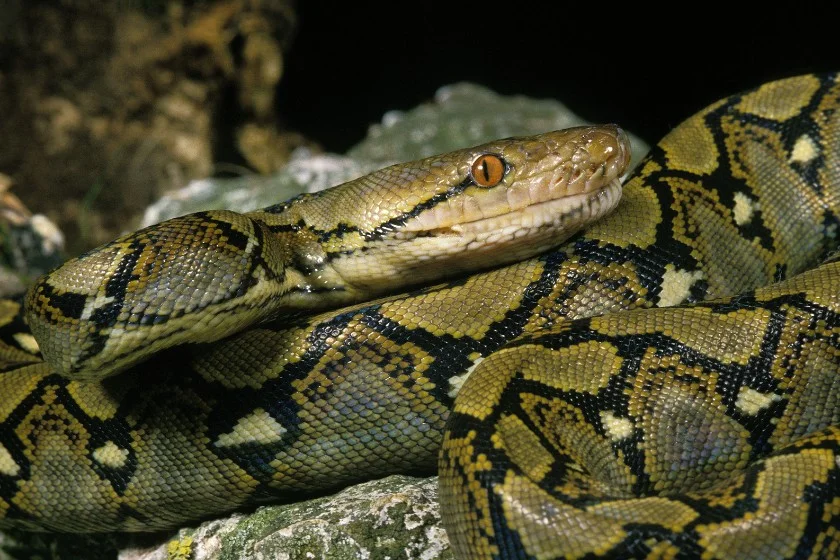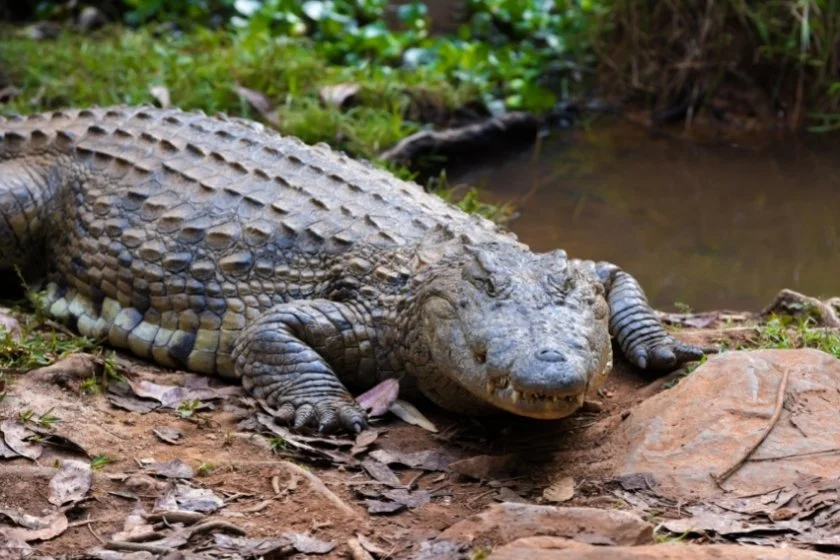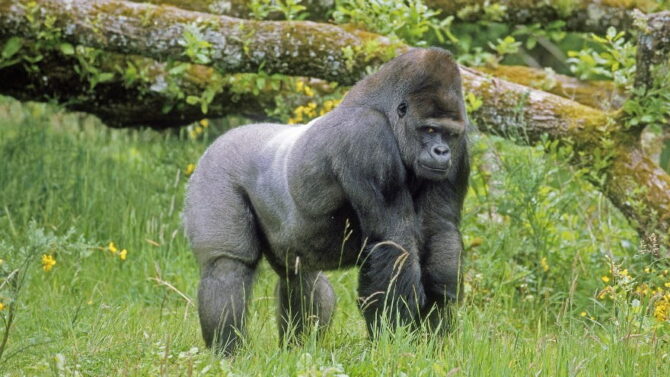The jungle is home to some of the most peculiar animals and plants on the planet, existing all over the world in tropical regions.
These habitats contain grasslands, rainforests, wetlands, and dense vegetative habitats that house creatures you are probably unfamiliar with.
Perhaps you are unfamiliar with their geographical range or distribution.
You are most likely familiar with the reticulated python, native to Thailand’s dense forests, or the anaconda, native to South America’s jungles; however, jungle animals like the Gaur and the Bonobo are some you may not be familiar with.
This article will go over some of the animals that live in the jungle and where you can see them.
Jungle Animals You Need to See
1. Green Anaconda

Scientific Name: Eunectes murinus
The green anaconda has a reputation for size as the heaviest and one of the longest extant snakes.
It is a constrictor endemic to South America, occurring in dense vegetative habitats in Venezuela, Bolivia, Peru, Brazil, Ecuador, Colombia, and the Guianas’ swamps, tropical rainforests, marshes, and slow-moving streams.
Mature anacondas average over sixteen feet and weigh up to 154 pounds. Green anacondas are constrictors, ambush attack specialists, and terrific swimmers.
Their abilities help them to overpower many animals, including large species like claimants and deer.
2. Bongo

Scientific Name: Tragelaphus eurycerus
In the tropical jungles of Central Africa, there is a big forest antelope called the bongo.
The bongo is one of the most striking antelopes in the world, as it spots a vibrant chestnut-brown coat and vertical white stripes.
Dive Deeper: Discover Amazing Animals With Stripes
This animal boasts of being the biggest forest antelope. The bongo is a nocturnal creature(active at night). Its diet consists of grasses and leaves.
The male and the female can both be seen with horns, with their pointed horns reaching a height of one meter.
3. Bonobo

Scientific Name: Pan paniscus
The Congo Basin in Africa is home to the bonobo, a primate. It inhabits communities of 30 to 80 individuals.
Bonobos live in lowland rainforests or swamp forests. As an omnivore, the bonobo will add insects and small mammals like rodents to its diet, which consist primarily of fruit and seeds.
The bonobo and chimpanzee are very similar in terms of both physical characteristics and way of life.
However, the bonobo is slimmer and has longer arms, a smaller chest, and a rounder head with a less projecting face.
4. Gorilla

Scientific Name: Gorilla
The largest primates other than humans are gorillas. Gorillas come in two species: western gorillas and Eastern gorillas.
Both are present in various forest ecosystems in addition to jungles. Mountain gorillas are a subspecies of the Eastern gorilla that lives in mountainous Central African forests.
The food of different species can vary, with the mountain gorilla typically consuming foliage, such as leaves, stems, and shoots.
A huge male gorilla, identified as a “Silverback,” leads his gang of gorillas.
5. Leopard

Scientific Name: Panthera pardus
The leopard is one of the most recognizable animals today with its spotted exterior, muscular yet sleek physique, and ringed tail. Much of Sub-Saharan Africa, as well as South and Southeast Asia, are home to the leopard.
Although they can be found in various habitats, leopards favor forested areas. Grassland savannas, forests, and woodlands are where they typically reside.
Leopards are carnivorous animals. Leopards get all the moisture they need from food, so they stay for long periods without drinking water.
6. Sloth Bear

Scientific Name: Melursus ursinus
Despite being the only species under the genus Melursus, the only species under the genus Melursus, you can find sloth bear populations in Asia’s jungles, including the tropical forests and grasslands of India and Sri Lanka.
Sloth bears feed on insects, thanks to their body modifications adapted for such feeding.
They have a long lower lip, palate, and extended, sickle-shaped claws to help them hunt insects.
7. Gaur

Scientific Name: Bos gaurus
The gaur is a bovid (any hoofed mammal in the family Bovidae) with a powerful and massive physique.
It has big ears and a pronounced ridge down its back. It boasts of being the biggest member of the family, Bovidae.
A typical gaur habitat includes large, nearly undisturbed timber tracts, hilly terrain, water accessibility, and an abundance of forage such as bamboo, shrubs, and trees. Gaur is indigenous to South and Southeast Asia.
8. Reticulated Python

Scientific Name: Malayopython reticulatus
The species was dubbed after its net-like scale pattern. The reticulated python is the world’s longest snake and one of the three heaviest.
It can grow to be over 6 meters / 19.7 feet long. The reticulated python is endemic to Thailand but is found throughout Asia.
Reticulated pythons can be found all over the Malaysian peninsula, Southeast Asia, and the Philippines and Indonesian islands.
They prefer to live in rainforests, woodlands, and grasslands but were once common in Bangkok’s busiest areas.
9. Javan Rhino

Scientific Name: Rhinoceros unicornis
While the unicorn is a mythical creature with one horn, the one-horned Javan rhino is a real rhinoceros species endemic to the Indian subcontinent.
It is revered as one of the continent’s endemic species, inhabiting its jungles, where it occurs in dense grasslands, reedbeds, large floodplains, and lowland rainforests in Java, Indonesia.
The rhino’s one horn, a feature shared with the Indian rhino, differentiates it from other rhinoceros species.
10. Tiger Quoll

Scientific Name: Dasyurus maculatus
The Tiger quoll (Spotted-tailed quoll or Tiger Cat) is Australia’s largest marsupial carnivore, found in Victoria, New South Wales, Queensland, and Tasmania.
They are identified by their dark-brown fur and irregular white spots on their back and tail. The species has a large bite for its size and hunts a variety of small to medium-sized animals.
They can be found in various habitats, including rock crevices, hollow logs, trees, clumps of vegetation, caves, and boulder tumbles.
11. Baird’s Tapir

Scientific Name: Tapirus bairdii
The Baird’s tapir is South America’s largest land mammal, reaching a maximum length of around 8.2 ft and weighing around 880 lb. It is a large mammal with a barrel-shaped body and a large head.
They feed on various leaves, twigs, fruits, and seeds. Their preferred habitat is moist lowland rainforests with a constant source of water.
This species can also reside in a wide range of habitats, including tropical forests, woodlands, grasslands, and marshes.
Their range includes small areas in Colombia, Ecuador, Costa Rica, Guatemala, Honduras, Mexico, Nicaragua, and Panama.
12. Poison Dart Frogs

Scientific Name: Dendrobatidae
Poison Dart Frogs elegantly adorn themselves in some of the brightest, most brilliant colors.
These frogs inhabit the jungles, ranging from Costa Rica and Colombia to Brazil’s tropical forests.
Where else could they be?
Their jungle habitat determines their colors, yellow, red, gold, blue, green, or black, providing safety for them while they are active during the day.
The jungle also provides shelter for the frogs’ prey, including ants, mites, and termites.
13. Jaguar

Scientific Name: Panthera onca
The jaguar is an apex predator in the rainforests due to its size, strength, and expert hunting ability.
This large, powerfully built cat has a pale orange coat with rings called “rosettes” on it. Jaguars can be found in Central America, North America, and South America.
Jaguars have even been spotted in Arizona, in the United States! Jaguars, on the other hand, are primarily forest creatures that prefer the dense rainforests of South America.
Jaguars are also found in grasslands and wetlands; they are good swimmers and prefer to stay near water. Jaguars are carnivorous, so they eat mostly medium-sized mammals.
14. Crocodile

Scientific Name: Crocodylinae
Thick-skinned and cold-blooded are just a few of the nicknames given to this semi-aquatic reptile.
Crocodiles are “a mouthful,” with huge mouths and massive teeth that vary in color and size depending on the species.
Crocodiles’ bellies have thicker skin than their backs. Crocodiles can be found in Africa, Asia, the Americas, and Australia’s tropical regions.
While some species, including the American crocodile, prefer saltwater habitats such as estuaries and cold areas, others, such as the gharial, prefer freshwater rivers and lakes in jungles like tropical rainforests.
Many crocodile species prefer to nest on land near bodies of water.
15. Sun Bear

Scientific Name: Helarctos malayanus
The sun bear, the smallest of the eight bears, is endemic to Southeast Asia’s jungles, occurring in the region’s dense deciduous and evergreen forests.
The jungle’s high dominance of trees and shrubs aids the sun bear’s arboreal lifestyle — the most arboreal of all bears.
The bear is well-adapted to climbing, with inward-turned front feet, flattened chest, and powerful forelimbs with large claws.
One can differentiate this bear from others due to its orange-to-cream-colored chest patch resembling a rising sun.
India, Vietnam, Bangladesh, Laos, Myanmar, Indonesia, Cambodia, Malaysia, China, and Thailand are some places to find a sun bear.
Frequently Asked Questions (FAQs)
What are some famous jungles?
Despite deforestation, climate, and other anthropogenic activities, some famous jungles constitute some of the world’s most important ecosystems. The Amazon Rainforest (South America), Congo Rainforest (Africa), Daintree Rainforest (Australia), Southeast Asian Rainforest (Asia), and Tongass National Forest (North America) readily come to mind.
What animals live in the trees in the jungle?
Not every animal in the jungle is terrestrial, as some are largely arboreal. Such species include the sun bear and apes.
Is wildlife only found in the jungle?
While the jungle hosts wild animals, wildlife spread across various ecosystems, from grasslands, prairies, woodlands, plains, and deserts. Even some suburban and urban areas have distinct wildlife forms.
What wild animals do not stay in the jungle?
Despite its title as “King of the jungle,” the lion does not stay in the jungle; the wild cat occupies the open savannahs. Other wild animals, including prairie dogs, raccoons, deer, and various snake species, do not live in the jungle.
Wrap Up
Every continent has its fair share of unique sights and animals that live in the jungle. But as it stands, animals once native to an area have ceased to exist in such places, while some are now endangered.1
Check out this article on the Rarest Animals In The World (With Pictures) to learn more.
However, a trip to the wilderness will allow you to admire the natural beauty of these jungle animals and feel the rush of being so close to nature. Precautions, though, should be taken before you make such trips.






